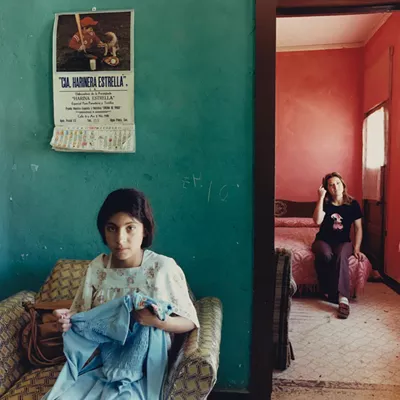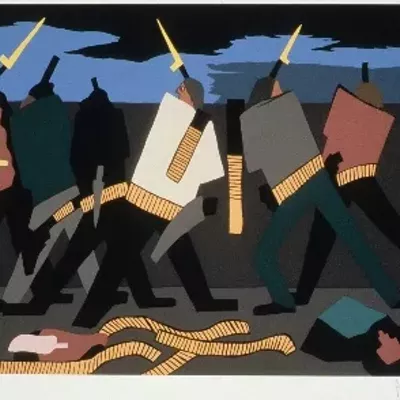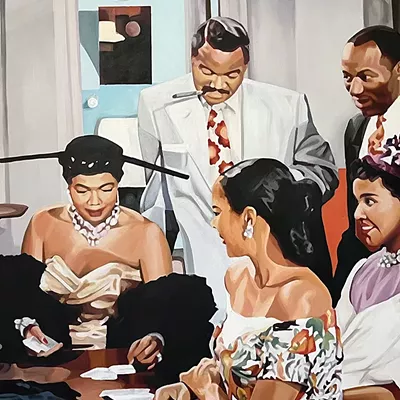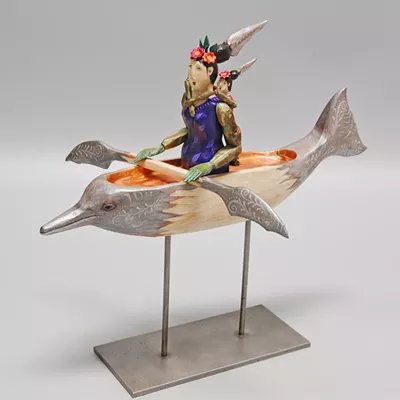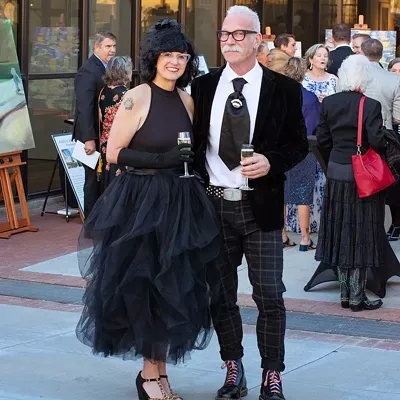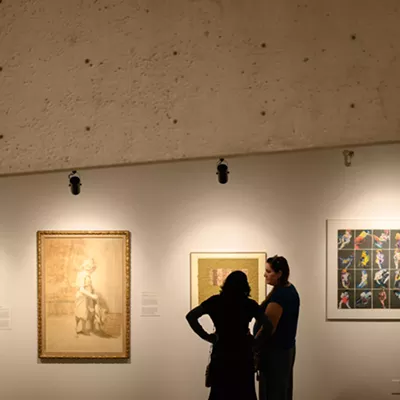Call it a clash of mid-century titans.
Superstar painter Jackson Pollock once called art giant Willem de Kooning a traitor to the cause of abstract expressionism.
"Bill, you betrayed it," Pollock declared in the early '50s at a party after a New York exhibition of de Kooning's new work. "You're doing the figure. You're still doing the same goddamned thing."
De Kooning's wild new paintings of the female nude struck Pollock as a grievous offense against the abstract ideal of pure painting, unpolluted by narrative.
The Woman paintings—including "Woman-Ochre," newly returned to the University of Arizona Museum of Art 31 years after it was stolen—fulfill most of the prerequisites of Abstract Expressionism. They're action paintings with energetic gestural strokes of paint careening across the canvas, spontaneous drips of paint, an ambiguous relationship between the foreground and background space.
But each of the works unmistakably pictures a recognizable figure, a cardinal sin in Pollock's eyes.
Those figures outraged another camp of critics, for different reasons. The Woman paintings were not only wild gesturally, they were savage pictorially. The women had huge and terrifying breasts, pointy teeth, body parts flung hither and yon in multiple pieces.
De Kooning "flays [the women], beats them, stretches them on racks, draws and quarters them..." critic Emily Genauer charged.
To Genauer and others, they were monstrous monuments to misogyny.
Of late, de Kooning has once again been lauded as one of the greats. After a major retrospective at the Museum of Modern Art in 2011, New York magazine critic Jerry Saltz rhapsodized over the "19 magnificent paintings and drawings of women" in the show, works that explosively launched art into "an entirely new world."
Tucson art lovers can decide for themselves where they stand in, oh, about a year's time. The UAMA's prized "Woman-Ochre" was damaged during its mysterious three-decade absence, and it won't be displayed anytime soon.
"We can't show it in its present condition," says curator Olivia Miller. "The canvas is very brittle. It was without temperature and humidity controls. Considering its history, it's fortunate that there isn't more paint loss."
A conservator recommended by the Willem de Kooning Foundation will undertake the restoration of the work. Luckily, the piece "is stable enough to travel" to the conservator's studio, Miller says. "We hope the work will be done within a year."
The Wild West tale of the theft of "Woman-Ochre" and its recovery in a house outside an obscure former mining town in New Mexico is just the latest episode in the tumultuous history of the Woman paintings. And it's a tantalizing new chapter—albeit a post-mortem one—in the larger-than-life bio of the late painter (1904-1997).
The very model of the macho, hard-drinking, womanizing artist, the Dutch-born de Kooning was painting like a Rembrandt by his early teens. He was apprenticed out at 12 to a design firm and did formal art studies at night, imbibing the lessons of the great masters.
At 22, he stowed away on a ship bound for Argentina and managed to slip into the U.S. at a Virginia port of call. He made his way to Hoboken, where he worked as a house painter, amassing experience in wielding a wide brush and painting in big strokes. A short jump over the Hudson River brought him into the energizing New York art scene.
The Dutchman worked for the Depression-era Works Progress Administration designing murals until his "alien" status was discovered; his firing deprived American post offices of potential masterpieces. In New York, de Kooning palled around with painters who would become household names, immersed himself in avant-garde shows at the Museum of Modern Art and painted non- stop. Giving up the old master styles of his youth, he made startling works that drew on cubism, surrealism and dada. Eventually, he burst into art-world fame with MOMA's landmark purchase of "Woman 1."
Improbably, "Woman-Ochre," painted in 1954-55, made its way to sleepy Tucson just a few years later, in 1958. How did the outback desert town latch onto a work by a top-flight New York artist?
Tucson's dude ranches can take partial credit. Life magazine had published an article about an UAMA exhibition of Renaissance works, curator Miller said. The article fell into the hands of Edward Joseph Gallagher, Jr., a Baltimore collector who liked to come out to Arizona and play cowboy at the ranches. Inspired, Gallagher called up then-UA President Richard Harvill and said he'd like to donate some works to the up-and-coming museum in honor of his late son.
That call ultimately led to a gift of more 200 American and Europeans works, including invaluable abstract expressionist paintings by Mark Rothko and Pollock, de Kooning's critic, and de Kooning's "Woman-Ochre."
That painting, featuring bold black lines, rich passages of turquoise and burnt sienna and a morose woman colored ochre, hung peacefully on an upstairs wall in the museum for 27 years. Then, early on Black Friday in November 1985, an unlikely pair—a young man and an older woman—slipped up the stairs, and stuck a knife into "Woman-Ochre." They sliced the canvas away from its frame, leaving tell-tale fibers behind, rolled it up and stole away.
The FBI was on the case, but as time passed with no real breaks, the museum placed a blank ochre-colored canvas on the woman's spot on the wall to memorialize the loss. As the years rolled by, de Kooning's reputation soared. The painting, valued at $400,000 in 1985, today could be worth as much as $160 million.
Thirty-one years after the painting vanished, David Van Auker happened upon it behind a door in a house outside Silver City, a violent 19th-century boom town turned art haven and hikers' paradise. A dealer at Manzanita Ridge Furniture & Antiques, Van Auker and his partners had agreed to a bulk buy in an estate sale at the home of a late couple identified as Rita and Jerry Alter.
On Aug. 1, when the team went to the house, Van Auker was checking out the mid-century modern furniture in the master suite. To get a better look at a dresser, he had to shut a door. There on the wall, behind the door, was something he thought was a "great, cool mid-century painting," he said later, at press conference in Tucson. The dealers returned a day later, piled their vehicle with the late couple's pottery and African works, and laid the priceless de Kooning atop the heap.
The next day, Aug. 3, Auker propped the "great, cool" work in the showroom. The first customer who arrived took one look at and demanded, "Have you guys researched this? I think it's a de Kooning."
A second client said the same thing. When a third customer also invoked de Kooning, a nervous Van Auker hid the painting in the gallery bathroom. He took to the internet, and within minutes, "there on the screen was a picture of the painting," along with an Arizona Republic story about the theft. Five minutes later, he was on the phone.
"I called UAMA and told the receptionist, 'I have a painting stolen from you,'" he recounted. The young woman, unfazed, crisply replied, "Hold please."
The call was forwarded to curator Miller. "I will never forget that phone call," she said. She had Van Auker send cellphone photos of the work. Once she saw the images, she was convinced that Van Auker had the long-lost de Kooning. After a flurry of calls to the FBI and consultation with university attorneys, The museum team set out for Silver City the next night.
Meantime, Van Auker was in a state of near panic, debating where to put what he now believed to be a major work of modern art. The gossip had gotten around that a masterpiece had materialized in Silver City and 40 people showed up at the shop wanting to see it. He called the FBI in Albuquerque and an agent dryly advised him to "find a very safe place to put it."
So Van Auker brought the de Kooning home.
Adding a further Wild West gloss to the tale, Van Auker stayed up all night Thursday in his house in the forest, guarding the avant-garde painting with his guns.
"I hid it behind my sofa," he said. "Then I got out my guns. I have three guns and positioned them around the house. I was paranoid. Every pop, every branch scraping against the house startled me."
In the wee hours, Van Auker worried. What if he stepped on the canvas accidentally and tore it? What if a forest fire raged through the Gila Wilderness and burnt "Woman-Ochre" to a crisp?
"I believe in Murphy's Law," he explained. "If something bad is going to happen, it will happen to me."
But Friday morning dawned peacefully, and the multi-million dollar painting was still safe behind the couch. Van Auker and one of the other partners got out of the house early and chauffeured the de Kooning around town, trying to locate someone willing to take it until the museum experts arrived.
They found a lawyer friend who's an art collector outside his house with his morning cup of coffee. The man laughed at the story of the de Kooning discovery – until he got a look at it. His eyes widened and he told the dealers, "OK, bring it in."
Late in the evening, the museum delegation arrived and were greeted at the door by the Grant County sheriff. The homeowner, celebrating with a party for friends and visiting family, led curator Miller into his home office, where the painting was leaning against a wall.
She knelt on the floor in front of it, and gasped.
"I was in awe," she said. "I wanted to soak in its texture, its colors and the wonderful teal patch on the shoulder." But all she could say, she admitted at the press conference, was "holy shitballs."
Tucson's de Kooning spent the weekend in a Silver City vault, to Van Auker's vast relief, and returned home in an armed convoy on Monday, Aug. 7. New Mexico state police escorted the museum van to the state line, then Arizona's state police stepped in, cruising with the de Kooning across I-10, through the Southern Arizona grasslands, past Bowie and Willcox and Benson, all the way back to the museum.
The painting was allowed to "rest" for a few days, and then Dr. Nancy Odegaard, a renowned conservator at the Arizona State Museum, gave the painting a thorough two-hour inspection, with the help of grad student Wendy Lindsey. The pair of them tallied up the evidence. A sticker from "Woman-Ochre's" appearance in a 1969 Smithsonian exhibition was still on the back. An ultra-violet light revealed the presence of an acrylic-based varnish that had once been applied to the paint. Earlier repairs, documented by the museum, had left telltale remains.
For the most important part of the exam, Odegaard had the Silver City painting placed atop the remains that the UAMA still had. The cuts in the newly arrived painting matched the cuts in the canvas scraps left behind in the museum so many years ago, and so did the colors still clinging to the threads. And, most decisively, a bold black stroke on the painting's top left corner lined up perfectly with a black stroke on the damaged remains.
The rescued work, Odegaard declared, was the real "Woman-Ochre."
Two days later, on Aug. 11, the museum announced to the world that the stolen painting had been found.
Unfortunately, the thieves had done it real harm.
"There was damage at the time it was stolen," Odegaard said at the press conference the following Monday. "A blade was used. There's a torn area near one corner. It was rolled tightly (by the thieves) and there's horizontal creasing on the canvas."
And when Odegaard and company removed the bad frame added by unknown miscreants, they found that some knucklehead had bored into the piece with—get ready—"large screws," the better to secure the junk frame to the masterpiece.
As Kimberly Espy, UA senior vice president for research, put it, "There were two crimes here. A priceless painting was stolen from the UA and it was stolen from our community."
Van Auker, relieved to have sent the multi-million dollar painting on its way, declared that he never considered perpetuating the crime and keeping the de Kooning for himself, not even for a second. As an Arizona native, he wanted the painting to get back to where it once belonged. And he rejected the halo that some people want to give him.
"I don't feel like a hero," he said, teary-eyed, at the press conference. "We returned something that was stolen. That's the way I was raised. We didn't even have a discussion about it."
Whether they love de Kooning or hate him, once the painting is restored and returned to the museum, students, scholars and Tucsonans of all stripes will be able to see a work important to the history of 20th century art.
"De Kooning played a major role in abstract expressionism, and this painting is seminal to our collection," said Miller, who couldn't stop smiling. "We all felt its loss."
The FBI investigation is still open, but the FBI is mum. Over in Silver City, the citizens have turned sleuths, Van Auker said, and wild speculation about the thieves' identity is raging. And giddy museum staffers, Miller reported, are "all wondering who will play us in the movie."

